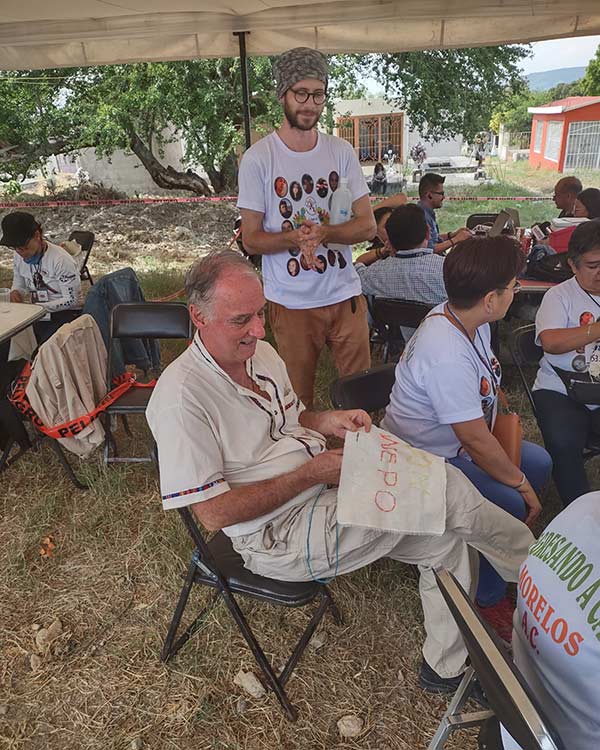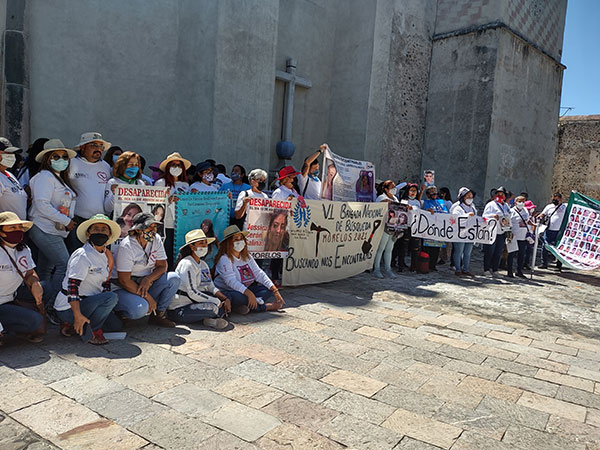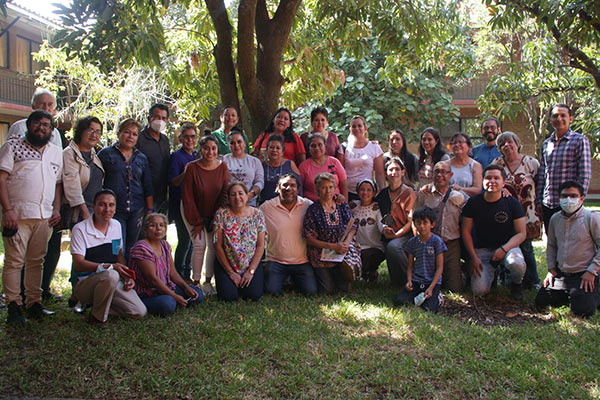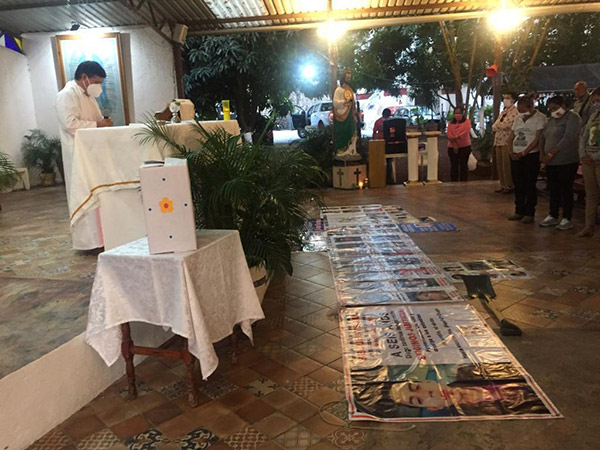Subtotal: $
Checkout
Building Peace through Nonviolence in Mexico
Critics of nonviolence often claim it is unrealistic in a situation of armed conflict. The work of Mexican peace activists shows otherwise.
By Pietro Ameglio and Myriam Fracchia
August 28, 2023
Available languages: Español
Since the beginning of the war in Ukraine, critics have suggested that, in conditions of armed conflict, nonviolent tactics are unrealistic, foolhardy, or even suicidal. But our thirty-five years working for peace through nonviolence in Mexico suggests otherwise. We believe it is important to share some lessons – of both Gandhian and Christian origin – that we have learned since cofounding Mexico’s chapter of Servicio Paz y Justicia (SERPAJ) in 1987. With roots in the Christian ecumenical movement, SERPAJ is a human rights organization that works for peace and justice through strictly nonviolent means. We work closely with UNESCO, and in 1980 Adolfo Pérez Esquivel, then president of our Argentinian chapter, was awarded the Nobel Peace Prize.
Context of the War
Mexico is not Ukraine, but we believe the situation in our adopted country (we came here from Uruguay as exiles fleeing dictatorship) approaches the level of low-grade war. Mexico, a country of over 128 million people, has the third highest poverty rate in the Americas. It also has one of the highest rates of economic inequality, with more than half of its workers depending on informal, off-the-books employment, without the protection of labor laws.

Pietro Ameglio at an event where the names of disappeared people were embroidered onto cloth as a way of preserving their memory. All photographs courtesy of the authors.
Since the 1990s, SERPAJ has seen a pattern of selective extermination emerge in Mexico. Unarmed civilians – social and human rights activists, relatives in search of the “disappeared,” government officials, political candidates, and journalists – have been killed with impunity. In recent decades, this situation has been compounded by the so-called “war on drugs.” The National Institute of Statistics and Geography – an autonomous agency of the Mexican government – estimated in 2022 that since 2006, when the “war” was declared, 300,000 people had been murdered and at least 66,000 “disappeared.” As a result of this violence there is a forensic crisis, with 55,000 unidentified bodies found from over 4,000 clandestine graves. By 2022, the official list of missing people in Mexico exceeded 100,000 people; this number has risen this year, according to some researchers, to 112,000. The number of Mexicans internally displaced by violence is expected to cross 400,000 by the end of 2023. Between 2018 and 2021, at least 141 human rights activists and 47 journalists were assassinated.
The agents responsible for this campaign of extermination are supported by some parts of the Mexican state. Criminal organizations run effective paramilitary forces, and their allies include sectors of civil society and elements of the army and police. Organized crime is a major player in human trafficking and in the black market in drugs and weapons. In Mexico, at least 150 criminal gangs are active: the biggest being the Sinaloa Cartel and the Jalisco Nueva Generación Cartel, which have connections across South America, Europe, Russia, China, Turkey, and beyond. In 2022, the US State Department suggested collusion between organized crime and state security forces lay behind the low rate of investigations or convictions for murders, disappearances, torture, and arrests. In June 2023, the International Crisis Group think-tank estimated that 166 of Mexico’s municipalities fit their criteria as “prone to capture” by criminal groups, 7 percent of Mexico’s total number of municipalities. Corruption of local government and police forces by organized crime prompted President Obrador to create a centrally controlled National Guard in 2018. Organized crime, President Obrador said, has become a powerful quasi-military force with “the clout of a global billion-dollar company,” and is “a threat to national security.”

First day of the 2021 National Brigade in Morelos.
The Spiral of Nonviolence
Those who doubt the effectiveness of nonviolent tactics are correct to point out how vulnerable those who enact them become. Mexican organized crime’s culture of extreme violence and lack of respect for human life greatly increases the chance that activists who oppose it – and their families – will be murdered.
But in our view violence only breeds more violence. The only way to put an end to the cycle is to convince both sides to drop their weapons. So the objective of our “peaceful civil resistance” – as nonviolent struggle is called in Mexico – is to use the “spiral of nonviolence” to halt the spiral of violence and even make it move in reverse, ultimately forcing those who use violence to move toward negotiations and agreements providing a fair solution for all involved parties. To do so we employ nonviolent tactics that are proportional to the violence we are facing; in our current context, forms of organized non-cooperation and civil disobedience. We also lean heavily on the Christian virtue of humility, as well as the Gandhian virtues of audacity and not asking permission from unjust government authorities.
There are echoes of the gospel in the slogans adopted by the mothers of the disappeared.
Since the effects of the long-running conflict have created a permanent sense of insecurity throughout Mexican society, we also need to respond to the emotional landscape violence creates. Specifically, we seek to face the terror gripping people and communities and push it back to one of fear. There is an important difference between terror and fear, as we understand the terms. While terror paralyzes people and leaves them vulnerable, fear helps them to strengthen their own defenses and organize a response to the threat.
Reform and Reintegration, Not Punishment
We have learned much about nonviolent resistance from indigenous communities. Thanks to their strong interpersonal bonds and traditions, indigenous peoples have been able to deploy strategies of nonviolent civil resistance much quicker than wider society. They have often engaged in acts of civil disobedience, occupying or blocking mines, forests, and rivers, when multinational corporations looked to steal the natural resources belonging to their communities. Likewise, in indigenous people’s defense of their territories against criminal gangs, some communities created neighborhood watches which have enjoyed some success in tackling crime. These are subject to local and regional assemblies where the elders have the final word, helping the new forces avoid continuing the spiral of violence. And they are experimenting how to “re-educate” the people they arrest. Instead of resorting to physical punishment, revenge, and humiliation, they try, in Gandhian style, to reintegrate the perpetrators of violence through community service jobs, or place them under the tutelage of families in other villages until they are able to return to their own homes.
Searching for the Disappeared
The other important actors for peace and nonviolence in Mexico are relatives of the disappeared and murdered. Ninety percent of these campaigners for justice are women, and we in SERPAJ have learned much from them over the last decade about peacebuilding. In just a few years, they have transitioned from being women with no interest in politics and social struggles, victims who didn’t understand why this misfortune had befallen them, to brave defenders of their loved ones’ honor when the authorities wanted to cast the disappeared as criminals, and defenders of human rights for all. Today the relatives of the disappeared are social activists who use nonviolent actions like non-cooperation and civil disobedience in their campaigns. They negotiate with authorities; organize marches, rallies, and pilgrimages; write in the press and organize demonstrations that catch the media’s eye; they fast, and hold masses and other religious services.

During National Brigades, people come together from all over Mexico to search for traces of the disappeared.
Their work has been of enormous value, to the campaigners as individuals and Mexican society as a whole. They have changed the country, from the law to academia. They are the ones who teach us methods of protest, organizing, and forensic research. They have a network encompassing hundreds of groups, their “second family,” communities that provide influence, protection, and support, both practical and emotional. This group solidarity is important because of the dehumanization and isolation that disappearances imply for the victim’s whole family. The social fabric around the disappeared disintegrates under the trauma of the event. Friends and relatives go from living to simply surviving, and they will never be the same again.
Most importantly, about ten years ago these women realized that state authorities will never try to find all the disappeared, because state forces are so often complicit in their disappearance. So the relatives of victims collectively took up the “search among the living and in clandestine graves.” They have faced threats and attacks of all kinds, both from state entities and from organized crime. But they have moved forward with increasing strength and organization, and have made a number of important discoveries, although there is still a long way to go due to the sheer magnitude of the disappearances in Mexico. These actions have changed the position of the authorities, who have been forced – at least in the case of the current federal administration – to support the searches in many ways.

Religous services are an important part of both the search for justice and the healing process. A “peace mailbox” appears beside this altar.
There are echoes of the gospel in the slogans these women have adopted. “We are not looking for bones, but for treasures” – love motivates their searching. “We do not seek revenge, but the truth” – the first step toward justice is to recover a minimally human life, which requires knowing the truth about their loved ones’ fate. But they seek the conversion, not the destruction, of their family members’ murderers. “Until we find them” – the searches will continue until they find all the disappeared, not just their own relatives. The task they have committed themselves to appears endless, but they are determined to keep going.
In addition to the searches carried out every day throughout Mexico, the relatives of the disappeared have organized a group to coordinate large-scale searches: the National Brigade for the Search of the Disappeared. Up to several hundred people from all over the country come together in the same state for several days to intensively investigate a particular location. These areas are chosen carefully: nearby there must be sufficient food and housing, as well as security for participants and information on possible grave sites. An ecumenical campaign called “I am the way, the truth and the life” has been very effective in turning up leads to unmarked burial sites. “Peace Mailboxes” – large cardboard boxes decorated by family members of the missing – are placed at the entrances of churches, temples, and schools. People are invited to place maps or information on possible clandestine graves into the box. This preserves the anonymity of those providing information – a necessary step given the high risk of retaliation. These campaigns have helped many searches uncover human remains.
Ultimately, we in SERPAJ are trying to combat violence by seeking to be more human every day. For the relatives of the disappeared, this process of humanization requires knowing the truth about the fate of their loved ones. But we also seek the humanization of those who perpetrate violence, as is best demonstrated by Mexico’s indigenous communities. We believe the nonviolent path to peace lies through the humanization of all actors: those harmed as well as those who do harm.
Already a subscriber? Sign in
Try 3 months of unlimited access. Start your FREE TRIAL today. Cancel anytime.








Michael Nacrelli
This is sobering and inspiring, but not very comparable to Russia's full-scale military invasion of Ukraine.
Chris
What an incredible story of courage and of following the Prince of Peace. Thank you. My heart and soul are touched by the devotion to peace and love shown by SERPAJ and the women searching for their loved ones.